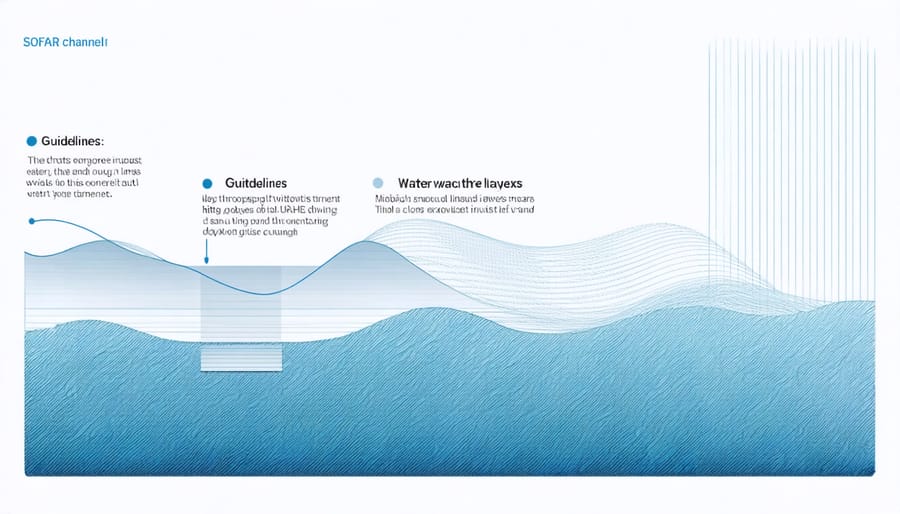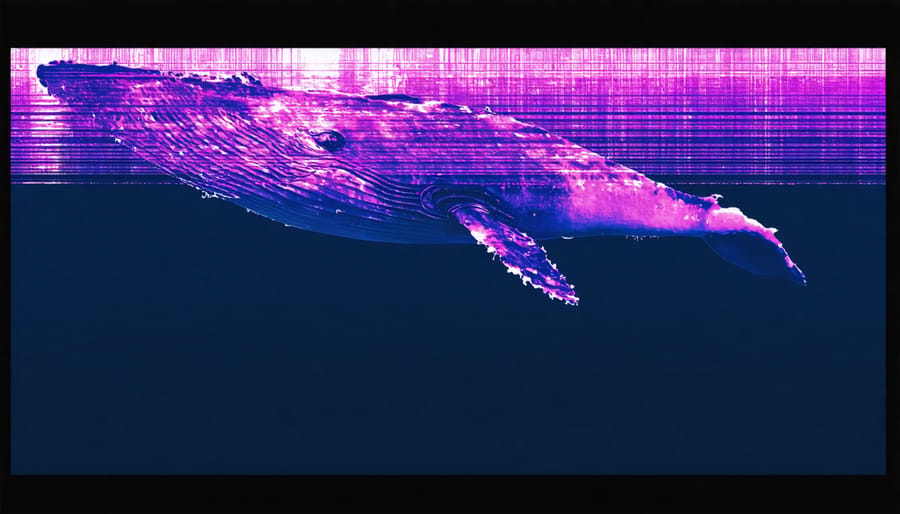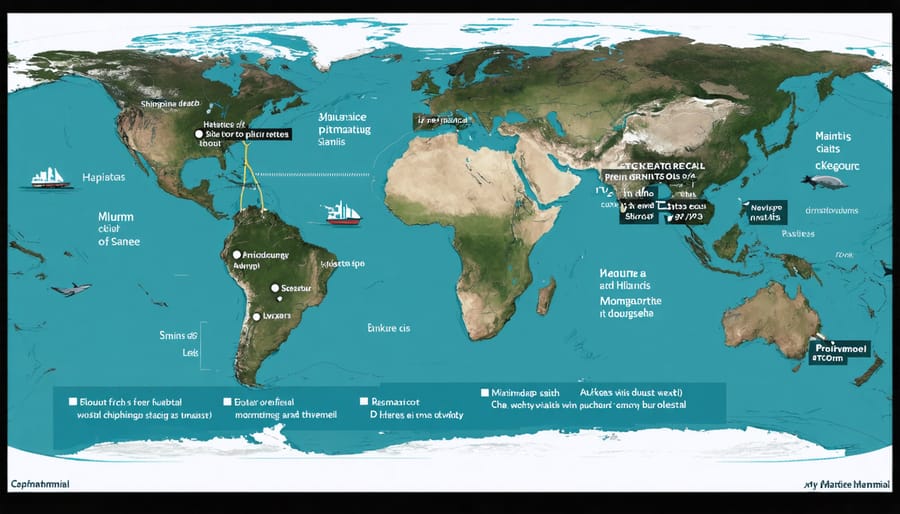
Beneath the ocean’s surface lies a symphony of sounds that shapes the very essence of marine life. From the haunting songs of humpback whales echoing across vast oceanic distances to the intricate clicking conversations of dolphin pods, acoustic communication represents one of nature’s most sophisticated evolutionary achievements.
In a world where light penetrates only the uppermost layers of our oceans, sound waves serve as the primary medium for information exchange, traveling efficiently through water and enabling complex social interactions, navigation, and survival strategies among marine species. This remarkable adaptation has evolved over millions of years, allowing marine mammals to develop sophisticated vocal repertoires that can traverse hundreds of miles of ocean depth.
Yet today, this ancient system faces unprecedented challenges. Human-generated noise from shipping, offshore construction, and military operations increasingly disrupts these vital communication channels, threatening the delicate balance of marine ecosystems. Understanding acoustic communication isn’t just about appreciating nature’s ingenuity—it’s about recognizing our responsibility to protect these invisible but essential pathways of life beneath the waves.
As we delve deeper into the science of acoustic communication, we’ll explore how these remarkable systems work, why they matter, and what steps we can take to ensure their preservation for future generations.
The Physics of Underwater Sound
Sound vs. Light in the Ocean
In the vast underwater world, sound travels nearly five times faster than it does in air, making it a remarkably efficient means of communication. Unlike light, which scatters and gets absorbed quickly, sound waves can travel for hundreds or even thousands of kilometers in optimal conditions. While bioluminescent deep-sea creatures have evolved fascinating ways to use light for communication, light penetration in deep waters is limited to just a few hundred meters below the surface.
Sound’s superiority in marine environments becomes even more apparent when considering factors like turbidity, depth, and time of day. While visual communication requires clear water and adequate lighting conditions, acoustic signals remain effective regardless of water clarity or time of day. This reliability has made sound the preferred method of communication for many marine species, particularly cetaceans, who have developed sophisticated systems of clicks, whistles, and songs to navigate, find food, and maintain social bonds in their underwater world.
The Ocean’s Sound Channel
In the vast expanse of the world’s oceans lies a remarkable feature known as the SOFAR channel (Sound Fixing and Ranging), also called the deep sound channel. This natural phenomenon occurs at depths between 600-1200 meters in temperate waters, where unique temperature and pressure conditions create a perfect pathway for sound waves to travel with minimal loss of energy.
Marine mammals, particularly whales, have evolved to take advantage of this acoustic highway. Blue whales and fin whales, for instance, produce their distinctive low-frequency calls at depths that align perfectly with the SOFAR channel, enabling their vocalizations to travel for thousands of kilometers. This remarkable adaptation allows these magnificent creatures to communicate with others of their species across entire ocean basins.
Scientists have documented cases where whale songs transmitted through the SOFAR channel have been detected up to 4,000 kilometers from their source. This natural acoustic channel plays a crucial role in maintaining social bonds between widely dispersed marine mammal populations, coordinating migration patterns, and finding mates during breeding seasons.
Research has shown that different species utilize varying frequencies within the channel, creating their own distinct communication lanes in this underwater sonic highway.

Types of Marine Mammal Vocalizations
Echolocation Clicks
Dolphins and whales possess an extraordinary ability to produce high-frequency clicks that enable them to navigate and hunt in the vast ocean depths. This sophisticated biosonar system, known as echolocation, works by emitting rapid sequences of clicks that bounce off objects and return as echoes, providing detailed information about their surroundings.
These remarkable creatures produce clicks by forcing air through specialized organs called phonic lips, located in their heads. The sounds then travel through their melon, a fatty organ that focuses the beam of sound waves into a directional signal. When these clicks encounter objects, the returning echoes are received through the animal’s lower jaw and conducted to the inner ear.
The precision of echolocation is astounding. Dolphins can detect objects as small as a golf ball from more than 100 meters away, and distinguish between different types of fish based on their acoustic signatures. They can even “see” inside other animals, detecting pregnant fish or spotting prey hiding under sandy seabeds.
Different species have evolved unique clicking patterns. Sperm whales produce powerful clicks that can reach depths of up to 2,000 meters, while harbor porpoises emit ultra-high frequency clicks that help them navigate in murky coastal waters. This diversity of acoustic strategies demonstrates the remarkable adaptability of marine mammals to their specific environmental niches.
Scientists studying these clicking patterns have discovered that each species has its own distinctive sound signature, helping researchers track populations and understand their behavior patterns in the wild.
Social Calls and Songs
Marine mammals use a diverse range of vocalizations for social bonding and reproductive purposes. Social calls help maintain group cohesion, coordinate hunting activities, and establish hierarchies within pods. These calls often include signature whistles in dolphins, which act like names, allowing individuals to recognize and locate specific pod members even in murky waters.
During mating seasons, male humpback whales produce complex songs that can last for hours and travel hundreds of miles underwater. These intricate compositions consist of repeated phrases and themes that evolve over time, with all males in a region adopting similar variations. Scientists believe these songs play a crucial role in female mate selection and male competition.
Mothers and calves maintain strong bonds through distinctive vocalizations. Beluga whales, known as “sea canaries” due to their varied repertoire, use specific calls to communicate with their young. These infant-directed vocalizations help calves learn their pod’s dialect and develop essential social skills.
Social calls also facilitate cooperative behaviors. Killer whales, for instance, possess pod-specific dialects that strengthen group identity and coordinate hunting strategies. These distinct vocal traditions are passed down through generations, creating unique cultural identities within different populations.
Recent research has revealed that some species even use “greeting ceremonies” when pods reunite, exchanging specific call sequences that help maintain social bonds and recognize family members after periods of separation.
Species-Specific Sound Signatures
Humpback Whale Songs
Humpback whales produce some of the most complex and haunting songs in the animal kingdom, with males creating elaborate vocal patterns that can last for up to 20 minutes and be heard from miles away. These songs consist of distinct themes and phrases, organized in hierarchical patterns that scientists are still working to fully understand.
During breeding season, male humpbacks perform these intricate compositions, which typically consist of various elements including moans, cries, and chirps arranged in specific sequences. What’s particularly fascinating is that all males within the same breeding population sing nearly identical songs, which gradually evolve over time. This synchronized evolution suggests a sophisticated form of cultural transmission among whales.
The songs play a crucial role in mate selection and male competition. While the exact purpose remains somewhat mysterious, researchers believe these vocalizations serve multiple functions: attracting females, establishing dominance among males, and potentially helping with spatial orientation during migration.
Perhaps most remarkably, humpback whales demonstrate cultural learning through their songs. Populations in different ocean basins may have entirely different songs, but when whales from different regions meet, they can adopt elements of each other’s songs, leading to the emergence of new hybrid compositions. This musical evolution provides valuable insights into cetacean culture and social learning.
Recent studies using advanced hydrophone technology have revealed even more subtle complexities in these songs, including previously undetected harmonies and rhythmic patterns. This ongoing research continues to deepen our understanding of these magnificent creatures and their sophisticated communication systems.

Dolphin Whistles and Clicks
Dolphins are renowned for their sophisticated acoustic communication system, which primarily consists of two distinct types of sounds: whistles and clicks. Each dolphin develops its own unique signature whistle by the age of one, serving as a personal identifier much like a name. These signature whistles help maintain group cohesion and allow individuals to recognize each other even in murky waters or at considerable distances.
Pod communication is facilitated through a complex array of vocalizations. Dolphins produce clicks for echolocation, using them to navigate and hunt by creating sound waves that bounce off objects in their environment. These clicks can be produced in rapid sequences called click trains, which provide detailed information about their surroundings, including the size, shape, and movement of nearby objects or prey.
Scientists studying dolphin pods have documented distinct whistle patterns that appear to coordinate group activities, from hunting strategies to social bonding. Mother dolphins begin whistling to their calves before birth, helping their offspring learn their signature whistle while still in the womb. This early acoustic imprinting strengthens the mother-calf bond and aids in recognition after birth.
Recent research has revealed that dolphins can remember each other’s signature whistles for decades, demonstrating remarkable long-term social memory. They also appear to use “name-calling” behavior, where one dolphin will reproduce another’s signature whistle to get their attention or request their presence, showcasing the sophistication of their communication system.
Threats to Acoustic Communication
Ocean Noise Pollution Sources
Ocean noise pollution has dramatically increased over the past century, creating significant challenges for marine species that rely on acoustic communication. Commercial shipping stands as the primary contributor, with tens of thousands of vessels creating constant low-frequency noise that can travel hundreds of kilometers underwater. These sounds often overlap with the frequencies used by whales and other marine mammals for communication.
Military and commercial sonar systems pose another significant threat. While essential for navigation and defense, these powerful sound waves can disorient marine life, disrupt feeding patterns, and in some cases, cause physical harm to sensitive marine species. High-intensity active sonar has been linked to several mass stranding events of deep-diving whales and dolphins.
Industrial activities, particularly offshore construction and resource exploration, generate intense underwater noise. Seismic surveys using airgun arrays create some of the loudest human-made sounds in the ocean, while pile driving for wind farm construction produces repetitive, high-intensity sounds that can affect marine life behavior and movement patterns.
Oil and gas drilling operations contribute continuous noise pollution through exploration, construction, and operational activities, creating acoustic disturbances that can last for months or even years in a single location.

Conservation Efforts
Numerous organizations and governments worldwide are implementing measures to reduce ocean noise pollution and protect marine acoustic communication. The International Maritime Organization has established guidelines for quieter shipping practices, including ship design modifications and speed restrictions in sensitive marine habitats. Several major ports now offer incentives for vessels that meet noise-reduction standards.
Marine protected areas increasingly include acoustic protection zones, where certain noisy activities are restricted during critical communication periods for marine mammals. Scientists and conservationists use passive acoustic monitoring systems to track noise levels and marine mammal presence, helping inform policy decisions and protection measures.
Public awareness campaigns have led to successful initiatives like the “Silent Seas” program, which encourages recreational boaters to reduce engine noise in whale-watching areas. Technology companies are developing quieter propulsion systems and underwater construction techniques that minimize acoustic impact on marine life.
Citizen science projects enable volunteers to participate in acoustic monitoring, while collaborative efforts between shipping companies and marine biologists have resulted in the creation of alternative shipping routes that avoid critical marine mammal habitats. These combined efforts demonstrate growing recognition of the importance of protecting marine acoustic environments.
The intricate world of marine acoustic communication stands as a testament to the remarkable evolution of life in our oceans. As we’ve explored throughout this article, these sonic networks are not just fascinating scientific phenomena – they are the literal lifelines that connect countless marine species, enabling their survival and prosperity across the vast underwater expanses.
However, this delicate acoustic environment faces unprecedented challenges from human activities. Rising ocean noise pollution, climate change, and habitat destruction threaten to disrupt these vital communication channels that have evolved over millions of years. The consequences of losing these acoustic pathways would be devastating, affecting everything from whale migration patterns to the survival of coral reef communities.
The good news is that we can make a difference. By supporting marine protected areas, advocating for stricter regulations on underwater noise pollution, and participating in citizen science projects that monitor marine acoustics, each of us can contribute to preserving these underwater soundscapes. Many organizations offer opportunities for volunteers to assist in acoustic monitoring programs or participate in beach cleanup efforts that help protect marine habitats.
Remember, every action counts – whether it’s reducing your carbon footprint, supporting sustainable fishing practices, or educating others about the importance of marine acoustic environments. The symphony of the seas has played for millions of years; it’s our responsibility to ensure it continues for generations to come. Together, we can protect these remarkable communication networks and the countless species that depend on them.
jessica
Ava Singh is an environmental writer and marine sustainability advocate with a deep commitment to protecting the world's oceans and coastal communities. With a background in environmental policy and a passion for storytelling, Ava brings complex topics to life through clear, engaging content that educates and empowers readers. At the Marine Biodiversity & Sustainability Learning Center, Ava focuses on sharing impactful stories about community engagement, policy innovations, and conservation strategies. Her writing bridges the gap between science and the public, encouraging people to take part in preserving marine biodiversity. When she’s not writing, Ava collaborates with local initiatives to promote eco-conscious living and sustainable development, ensuring her work makes a difference both on the page and in the real world.
